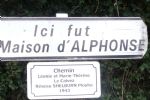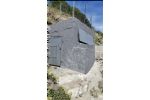TheShelburn network was a branch of the Special Operations Executive of the British secret service, whose mission was the repatriation to England of Allied paratroopers and airmen whose aircraft had been shot down in the skies over France. The network mainly covered western France; it was set up by police administrative officer Paul Campinchi
As early as May 1943, several airmen were transferred to the Saint-Brieuc region with a view to repatriation, which the British Admiralty postponed until autumn. The airmen were then to be flown back to Paris, before being redirected to Spain. During this operation, a British emissary was arrested: the loss of the code led to the breaking of links with England, even though the repatriations continued. Funds running out, Campinchi sends the second British emissary back home in August 1943, to report on the situation. A few days later, in his absence, his PP home and office were raided by the Germans. He then had to go into hiding. He makes contacts in Douarnenez to reconstitute a line of escapes, when his emissary returns from London and enables the reconstruction of a network that brings Admiralty speedboats to pick up fugitives near Saint-Brieuc, in Cochat cove. These missions, dubbed Shelburne, are organized by the War Office's MI9, whose IS9d section is responsible for coordinating escape routes from occupied Europe: the PP man is "one of their best agents in the Paris region". Campinchi eventually tracks down the first emissary, Val Williams, arrested by the Germans, who, having escaped and been wounded, has ended up in Bain-de-Bretagne. He is loaded onto the Saint-Brieuc-Paris train, and is picked up at Versailles station by two gendarmes who handcuff him.
The trio made their way effortlessly through German controls at the Gare du Maine. Campinchi's accomplices had succeeded in their exfiltration. would later be repatriated to Britain. The réseau Shelburnor François network, of which Campinchi was the creator, numbered 869 agents in March 1943. The history of the structure shows its strong involvement in airmen's escapes: around forty went through Spain in 1943, then by fishing boat thanks to the Bonaparte plan. In all, more than 150 men were exfiltrated by several methodically organized teams. A group of trackers was set up in Nord-Pas-de-Calais and Oise.
A group of conveyors existed in Saint-Brieuc and Guingamp. Le Plan Bonaparte concerns the Côtes-du-Nord, and reveals Campinchi's sense of organization, with a beachmaster and some twenty landlubbers, convoyers and guards, and strong connections with the British Navy. Departures were by sardiniers from Douarnenez and Roscoff. Other plans with the same organization will not be implemented, such as Austerlitz (Finistère) or Achille (Alpes-Maritimes). The network depended directly on the British General Staff. Highly structured, Shelburn included teams for screening and security, as well as others for convoys, accommodation, false documents and laboratories (maintenance of equipment, photos, care, etc.). He will be the beneficiary of two parachute drops (Seine-et-Oise and Truchy -Aisne-). He will have 30 killed and 46 deported.
Campinchi is assisted at the head of the network by his PP accomplice, de docteur Porc'her, who takes charge of the network's printing works. Mrs. Campinchi is the secretary. Campinchi died in Paris in February 2003: he was a Lieutenant-Colonel, Officer of the Légion d'Honneur, and holder of the Croix de Guerre and the Médaille de la Résistance with rosette, as well as foreign decorations: Officer of the British Empire, Officer of the Order of Leopold, Croix de Guerre du Luxembourg, American Liberty Medal...
Source Wikipedia
Photo credit Le Bourvellec Eric
TheShelburn network was a branch of the Special Operations Executive of the British secret service, whose mission was the repatriation to England of Allied paratroopers and airmen whose aircraft had been shot down in the skies over France. The network mainly covered western France; it was set up by police administrative officer Paul CampinchiAs early as May 1943, several airmen were transferred to the Saint-Brieuc region with a view to repatriation, which the British Admiralty postponed until autumn. The airmen were then to be flown back to Paris, before being redirected to Spain. During this operation, a British emissary was arrested: the loss of the code led to the breaking of links with England, even though the repatriations continued. Funds running out, Campinchi sends the second British emissary back home in August 1943, to report on the situation. A few days later, in his absence, his PP home and office were raided by the Germans. He then had to go into hiding. He makes contacts in Douarnenez to reconstitute a line of escapes, when his emissary returns from London and enables the reconstruction of a network that brings Admiralty speedboats to pick up fugitives near Saint-Brieuc, in Cochat cove. These missions, dubbed Shelburne, are organized by the War Office's MI9, whose IS9d section is responsible for coordinating escape routes from occupied Europe: the PP man is one of their best agents in the Paris region. Campinchi eventually tracks down the first emissary, Val Williams, arrested by the Germans, who, having escaped and been wounded, has ended up in Bain-de-Bretagne. He is loaded onto the Saint-Brieuc-Paris train, and is picked up at Versailles station by two gendarmes who handcuff him. The trio made their way effortlessly through German controls at the Gare du Maine. Campinchi's accomplices had succeeded in their exfiltration. would later be repatriated to Britain. The réseau Shelburnor François network, of which Campinchi was the creator, numbered 869 agents in March 1943. The history of the structure shows its strong involvement in airmen's escapes: around forty went through Spain in 1943, then by fishing boat thanks to the Bonaparte plan. In all, more than 150 men were exfiltrated by several methodically organized teams. A group of trackers was set up in Nord-Pas-de-Calais and Oise. A group of conveyors existed in Saint-Brieuc and Guingamp. Le Plan Bonaparte concerns the Côtes-du-Nord, and reveals Campinchi's sense of organization, with a beachmaster and some twenty landlubbers, convoyers and guards, and strong connections with the British Navy. Departures were by sardiniers from Douarnenez and Roscoff. Other plans with the same organization will not be implemented, such as Austerlitz (Finistère) or Achille (Alpes-Maritimes). The network depended directly on the British General Staff. Highly structured, Shelburn included teams for screening and security, as well as others for convoys, accommodation, false documents and laboratories (maintenance of equipment, photos, care, etc.). He will be the beneficiary of two parachute drops (Seine-et-Oise and Truchy -Aisne-). He will have 30 killed and 46 deported. Campinchi is assisted at the head of the network by his PP accomplice, de docteur Porc'her, who takes charge of the network's printing works. Mrs. Campinchi is the secretary. Campinchi died in Paris in February 2003: he was a Lieutenant-Colonel, Officer of the Légion d'Honneur, and holder of the Croix de Guerre and the Médaille de la Résistance with rosette, as well as foreign decorations: Officer of the British Empire, Officer of the Order of Leopold, Croix de Guerre du Luxembourg, American Liberty Medal...Source WikipediaPhoto credit Le Bourvellec Eric






